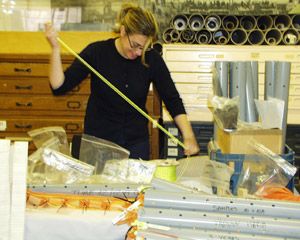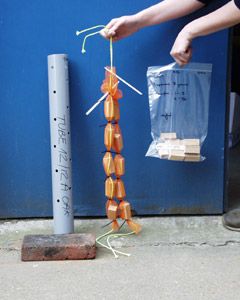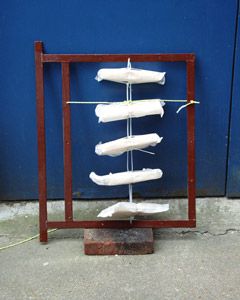 MoSS United Kingdom >
The main themes >
Monitoring >
MoSS United Kingdom >
The main themes >
Monitoring >
| MoSS United Kingdom |
| MoSS Deutschland MoSS Nederland MoSS Danmark MoSS Sverige MoSS Suomi |
| MoSS | What's on? | The main themes | The wrecks of the project | Links |
| Monitoring Safeguarding Visualizing Chosen actions |
 MoSS United Kingdom >
The main themes >
Monitoring >
MoSS United Kingdom >
The main themes >
Monitoring >
|

Wooden samples to be located in the sediment are packed in plastic tubes. 
Wooden samples to be located at the three different werck sites. 
Part of the wooden samples are wrapped in geotex gauze. |
Monitoring ProcessThe monitoring process is the first of the three stages considered in the EU Project "Monitoring, Safeguarding and Visualizing North European Shipwreck Sites". A monitoring strategy will be applied from the end of May 2002 to the three wrecks sites Vrouw Maria (Finland), Darsser Kogge (Germany) and Burgzand Noord 10 (The Netherlands), that will measure the environment at variables that act on underwater archaeological sites. Very often these variables may be identified as threats to the preservation and the survival of a site. Therefore the monitoring procedure aims to identify and analyze the potential dangers in order to study and provide the right methodology for conducting and possibly piloting the development of monitoring protocols. It is fundamental to assess the environmental dynamics as well as analyze the sediments that encapsulate archaeological material. The investigation of the site formation processes will be focused on chemical, physical and biological factors. The biological aspects to be researched are the presence of bacteria and marine fungi activities as well as that of wood boring animals and human activities. The chemical aspects to be investigate water quality and the chemistry of the sediment. The physical aspect will focus on sediment and water movements and erosion of timbers or artifacts. In addition, where possible, an analysis of the marine archaeological landscape will be carried out through a detailed geographical survey with video-imaging and recording. The monitoring process of the three wreck sites, the objects of investigation in the MOSS Project, will be carried out during a 18 months period. At each wreck site, wooden samples will be placed within the wreck environment and samples will be prepared for different monitoring lengths: 3 months, 1 year, 2 years, 3 years, 5 years, 10 years, 50 years. Samples will consist in archaeological waterlogged oak, fresh oak and pine blocks, in duplicates, and placed in the site in different conditions:
Each wooden sample has been weighed before being placed in its net and will be weighed after collection from the site. Seasonal differences will be determined. In addition, to this phase, the monitoring process will deploy data loggers to study the physical conditions of the surrounding seawater and sediments of each site, such as temperature, salinity, dissolved oxygen, suspended solids, pH and Redox in sediments. The Mary Rose Archaeological Services Ltd (Portsmouth, UK) will organize and co-ordinate the monitoring process, and will analyze the data once collected, supervising, interpreting and disseminating the results. The National Museum of Denmark is also playing a key role in this part of the monitoring project. |
Registration period for the Portsmouth Seminar over. |


|